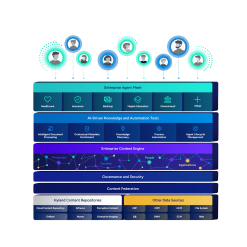The 7 benefits of SaaS-delivered healthcare for enterprise imaging
Imaging studies in 2020 accounted for approximately 2.4 exabytes of data. All the words ever spoken by humans would consume 5 exabytes of data.

Harness the power of a unified content, process and application intelligence platform to unlock the value of enterprise content.
Learn more
Automate your document-centric processes with AI-powered document capture, separation, classification, extraction and enrichment.
Learn about Hyland IDPIt's your unique digital evolution … but you don't have to face it alone. We understand the landscape of your industry and the unique needs of the people you serve.
 Overview of industries
Overview of industries
Countless teams and departments have transformed the way they work in accounting, HR, legal and more with Hyland solutions.
 Overview of departments
Overview of departments
We are committed to helping you maximize your technology investment so you can best serve your customers.
 Overview of services
Overview of services

Discover why Hyland is trusted by thousands of organizations worldwide.
Hear from our customers
Our exclusive partner programs combine our strengths with yours to create better experiences through content services.
Overview of partners
Join The Shift newsletter for the latest strategies and expert tips from industry leaders. Discover actionable steps to stay innovative.
Register now
Hyland connects your content and systems so you can forge stronger connections with the people who matter most.
Learn about HylandWith our modern, open and cloud-native platforms, you can build strong connections and keep evolving.
 Dig deeper
Dig deeper
December 13, 2022
Reading time minutes
Imaging studies in 2020 accounted for approximately 2.4 exabytes of data. All the words ever spoken by humans would consume 5 exabytes of data.

Tom Tennant
Content Creation & Content Services

In this piece:
Many healthcare organizations are tackling the challenge of medical imaging and on-premise storage.
At a time when the volume of data is growing at astronomical rates — not to mention that demanding team members be on-premises when they could work remotely, at least part of the time — grows increasingly challenging, our healthcare teams are rapidly adopting Software as a Solution (SaaS).
Data volume and storage needs are increasing
Hospitals and health systems generate more than 33.9 million MRIs and 80 million CT scans annually, a number most expect will only grow. Those are all tangible numbers IT departments can at least wrap their heads around. Then, add the growing practice of point-of-care imaging. Approximately 75% of medical images captured today are non-DICOM in nature, generated in departments and disciplines outside radiology and cardiology. Perhaps what’s harder to visualize, but with far more impact for any healthcare system with an on-premises enterprise imaging strategy, is how those same images are also expanding in size. The shift from two-dimensional to three-dimensional imaging alone can boost image file sizes by more than 20 times. Overall? Imaging studies in 2020 accounted for approximately 2.4 billion gigabytes of data. For comparison, one gigabyte is equal to about 300 iPhone photos. Healthcare systems are starting to feel the pressure of continuously updating and adapting on-premises IT and physical infrastructure so they can adequately store and manage increasing imaging data. It can be both an expensive and time-intensive process, especially if a healthcare organization suddenly has to swiftly scale up its storage capacity.
In order to meet this challenge head on, healthcare organizations have an option. Shifting content such as enterprise images from on-premises databases to Software as a Service (SaaS) technology hosted in the cloud provides organizations with the ability to quickly adopt and implement new technology and solutions. In other words, a SaaS strategy helps hospitals scale up at a moment’s notice, enabling them to tap into the added storage and computing power available from a SaaS provider and can do so almost immediately, whenever the need arises. This can be extremely beneficial in handling an influx of medical images during a crisis, as we saw with cloud-enabled healthcare teams during and throughout the COVID-19 crisis, or in launching new technology like high-resolution CT scans or computed radiography. In addition to exceptional support from the SaaS provider, the technology delivers more than simple storage and access.
Technology infrastructures based on modern, cloud-based architectural styles — such as REST (Representational State Transfer) and APIs (Application Programming Interfaces) — help ensure speed of implementation and deployment. They also allow quick integration into the enterprise-imaging architecture of those outlying departments.
Upgrades managed by a SaaS provider occur faster and more often than traditional on-premises systems, which also tend to have higher up-front costs. Those providers should offer service support around the clock, as well, when you deploy upgrades and new solutions, ensuring staff and clinicians are always able to access patient information when they need it.
Hear from experts about how COVID-19 has impacted enterprise imaging. Read Exploring the future of enterprise imaging in a COVID-19 world.
Leveraging SaaS-based enterprise-imaging technology in the cloud allows a healthcare organization to quickly adopt new technology and implement solutions remotely alongside its vendor partner. Leading SaaS providers essentially offer exponential growth opportunities, from storage space to additional servers for supporting growth in applications, processing and more. This eliminates the worry about the amount of available space for storage, essentially providing the key feature of any future-proofing strategy for enterprise imaging.
SaaS-based versions of core enterprise-imaging solutions provide an optimized and scalable architecture, ensuring staff and clinician access to imaging content regardless of volume or specialty. And as long as the provider is outfitted with a web-enabled device, they can access imaging information where and when needed. This allows a doctor to review imaging results with a patient via tablet by the bedside or in an office.
If a hospital’s entire technology stack lives within its four walls and access to that infrastructure becomes unsafe or untenable, work halts and the ability to access critical patient information, including images, could be compromised. The cloud eliminates this concern. The Hyland Cloud, for example, provides the highest levels of availability and uptime — 99.99% uptime, 24 hours a day, seven days a week, all year round.
As healthcare systems become accustomed to the power of their enterprise-imaging cloud solution, they can easily leverage the scalability and flexibility of the cloud to add analytics, artificial intelligence (AI) and actionable insight to their medical images. All furthering the mission to provide the best patient care possible.
The compounded growth of medical images and video, along with EMR data, combined with the emergence of genomic data and information from the Internet of Things has outgrown the computing power capabilities of most on-premises healthcare data centers. With the added computing power necessary to take advantage of AI and machine-learning initiatives, healthcare organizations need a solution that can not only store that kind of information, but ensure it is properly encrypted and fully redundant. It requires an infrastructure that, for most, is only realistically available in the cloud.
A strong, accredited healthcare SaaS solution can provide better security and higher availability than many organizations can achieve with their on-premises strategy. This puts the critical information where it needs to be — in the hands of clinicians, when and where they need it. More than 50% of the U.S. healthcare market, as well as innumerable healthcare organizations around the world, use Hyland products for their healthcare SaaS. Learn more about why Hyland is at the heart of connected health.